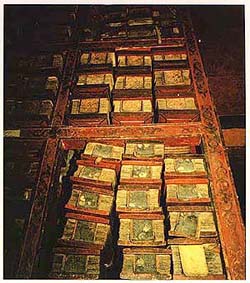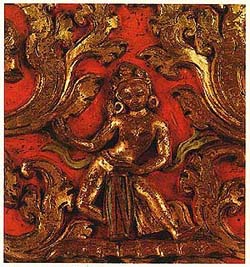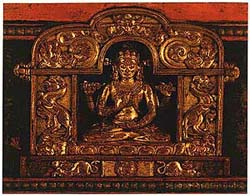

Until the Chinese occupation beginning in 1950, most Tibetans were bound by a single philosophical ideal - adherence to the Buddhist faith. For nearly 1200 years, they cultivated the spiritual, philosophical, and literary traditions of Buddhism with unparalleled zeal. Buddhism was originally introduced to Tibet from India in the seventh century and was championed by its rulers until the middle of the ninth century, when King Lang Darma, resentful of the growing power of the clergy, subjected it to brutal persecutions. In the eleventh and twelfth centuries, Buddhism was again introduced to Tibet, as Tibetans travelled to India to study and Indian masters journeyed across the Himalayas to bring teachings and texts to a vast new territory. Tibetans looked upon India as the Buddhist homeland until the middle of the thirteenth century, when Muslim forces from Turkey extinguished Indian Buddhism in a final series of punishing raids.
The Indian scholars, teachers, and monks responsible for the final dissemination of Buddhism in Tibet brought with them a crucial vehicle for transmission of the faith: texts - handwritten and often beautifully illustrated - in which the doctrine was painstakingly committed to written form. As late as 1937, the Indian scholar Rahula Sankrityayana discovered hundreds of Indian texts in Tibetan monasteries, where they had been lovingly preserved for nearly one thousand years. Monasteries in eastern India had brought the art of the book to great heights, and the libraries of monastic universities such as Nalanda - supported by the Pala rulers of eastern India (8th-12th centuries) - enjoyed international acclaim.
A substantial portion of this Buddhist literary corpus made its way into Tibet before Buddhism's demise in India. As early as the seventh century, Tibetans began translating Sanskrit works into the Tibetan language. By the eighth century, during the time of King Trisong Detsen (r. 755-797), translations had become a state-sponsored activity. An auspicious one hundred and eight translators were said to have been dispatched to India for training in Sanskrit. When they returned, Samye, Tibet's oldest monastery, became the centre of their translation work and eventually became Tibet's first main library. During the time of Trisong Detsen's sons, the question of cataloguing the translations arose. The Mahavyupatti was written at this time and addressed issues of orthography, grammar, and translation rules. However, since such royal decrees were disregarded outside Samye, these changes were not uniformly observed for many centuries. The Mahavyupatti is also a well known lexicon, containing a word list of Sanskrit-Tibetan equivalents. Students of Tibetan language still refer to this compendium today.
The Indian Buddhist canon, known in Sanskrit as the Tripitaka or "Three Baskets" (referring to the vinaya, rules of monastic conduct, sutras, the Buddha's own teachings, and Abhidharma, commentaries), was translated into Tibetan by the twelfth century. In Tibet, it was known as the Kanjur (texts considered to be the Buddha's own teachings) and Tanjur (commentaries on these). The Tibetan Buddhist canon was first assembled in the thirteenth century by Buton Rimpoche (1290-1364). Also throughout the eleventh to the fourteenth centuries, hundreds of monasteries were founded, each ideally requiring their own libraries.

The primary inspiration for Tibetan book covers (Tib.: glegs-sin) during this period of intensive translation was eastern India. The format of Indian mediaeval book covers - and that of the related tradition in Nepal - was fairly uniform. The birch bark or palm leaf pages, and therefore their protective wooden covers, were long and narrow, with measurements ranging from circa 7x41 cm. to circa 6x55 cm. While Tibetans considered the contents of these texts profoundly sacred and made every effort to unerringly translate them into their own language, the Indian format of the texts was not always strictly observed. Thus, while some ca. twelfth century Tibetan book covers resemble the Indian dimensions described above (as with nos.1 and 2 in the catalogue) and even a few examples demonstrate the continuation of this tradition as late as ca. 1400 (no. 29), the majority of Tibetan covers are much larger, measuring, on average, circa 26x73 cm.
Indian and Tibetan books are constructed in essentially the same manner. Leaves are stacked on top of one another and protected by wooden covers placed above and below. The Indian book is bound by one or two strings which pass through each page and the wooden covers and, when not in use, are wrapped several times around the covers to secure the pages safely within. Most eastern Indian mediaeval manuscripts are written on palm leaves cut from the palm plant, and the size of the pages reflected limitations in the size of the palm leaf itself. Moreover, palm leaves become brittle with age, and were probably perceived to have an optimal size of no longer than about 50 cm. No such practical considerations governed the size of Tibetan books, which were written on paper imported from China. As the pages grew, so did the size and weight of their covers. Only a strap was needed to secure the covers when they enclosed the manuscript, although a cloth was also sometimes used to further wrap the manuscript and thus keep it free of dust and smoke when not in use. Text is written on both sides of the pages of Tibetan books. When the upper cover is removed and inverted, the title is read on the first page. It is then turned over to read its verso and when finished, placed on top of the already inverted cover and so on, to the end of the volume.
Though plentiful in portions of eastern Tibet, hardwood is relatively rare in central Tibet. Thus, little expense was spared in producing these large wooden covers, reflecting the importance of the texts which they bound and protected, Magnificently carved, gilded and painted, these works were once highly treasured by Tibetan monasteries, where they were stacked by the hundreds in an orderly display.

After the fifteenth century, apart from the countless extra-canonical texts used by monks and scholars, every monastery aspired to have the complete Buddhist canon - 100 or 108 volumes of the Kanjur and 225 volumes of the Tanjur; in all, these two canons contain 4,569 texts. Before the Chinese invasion, there were said to be between 3000 and 5000 monasteries in Tibet, of which probably more than 90% were partially or entirely destroyed. The sacred content of their libraries met a similar fate.
Those which survive reveal some of the splendour that once existed in this little known genre of Tibetan art. Even the simplest of covers were carved and painted with consummate skill. Combining the abilities of sculptor and painter, those who produced these works are deserving of admiration in equal measure to that afforded their colleagues who produced the murals, the paintings (thangkas), and the wood, clay, and metal sculptures with which we are familiar.

It is clear that some of the early manuscripts and covers from India and Nepal are gloriously decorated, but there appears to have been no precedent for the extraordinary range of design in so many Tibetan book covers. From the intertwined acrobatic figures of no. 11 (in the catalogue; in the on-line exhibition, no. 4), to the striking elegance of the scroll work in no. 12 (in the catalogue), the Tibetan artist continually surprises with delightful innovations, all the while skillfully adhering to iconographic norms.
The majority of Tibetan book covers are made of wood with some notable exceptions. Ivory carving and moulded clay images are inset into niches in already carved wooden covers. Repoussé gilt metal adornments can also be found, probably observing a tradition which flourished in the Kathmandu Valley. Book covers in the library of Drepung have been observed to be edged in carved ivory. More than any other Buddhist culture, Tibet lavished extraordinary care on the wooden covers which protected their sacred texts. Although we do not know their artists' names, and only occasionally the names of their benefactors, the passion and exuberance of those who made these covers are evident in these splendid works.

None of the book covers in this volume bears an inscription allowing a firm, incontrovertible date. However, dates are ascribed to these works by comparison with other forms of Tibetan art, for which increasingly reliable chronological guides exist. Central Asian sites, notably Kharakhoto, also serve as a guide for dating, as do dated eastern Indian and Nepalese illuminated manuscripts and book covers. In this evolving field, discrepancies in dating are to expected. Some covers may eventually be dated later than is suggested here and others earlier; but there can be no doubt that the majority may confidently be described as early Tibetan works of art.
David Weldon
July 1996
